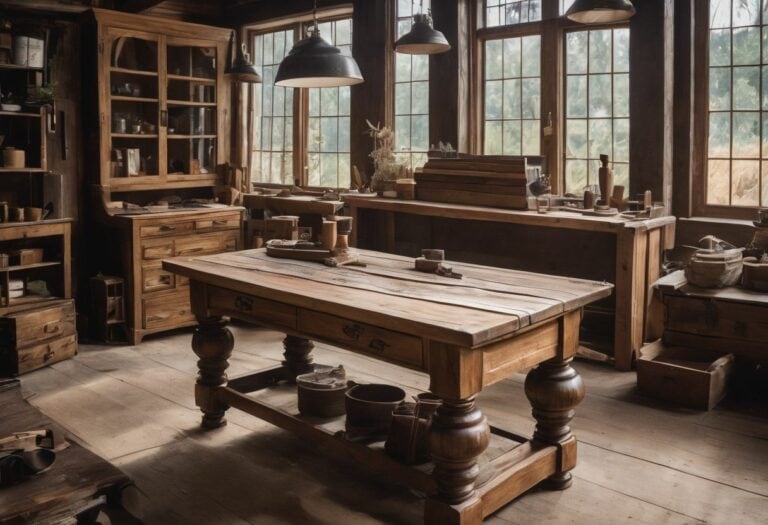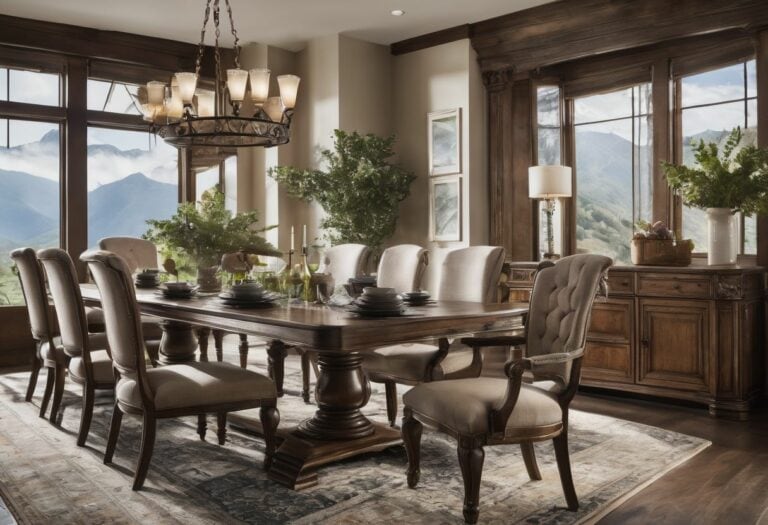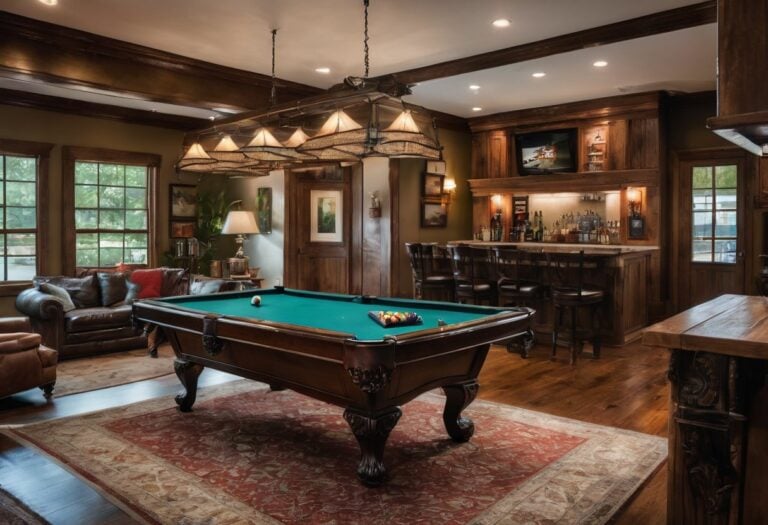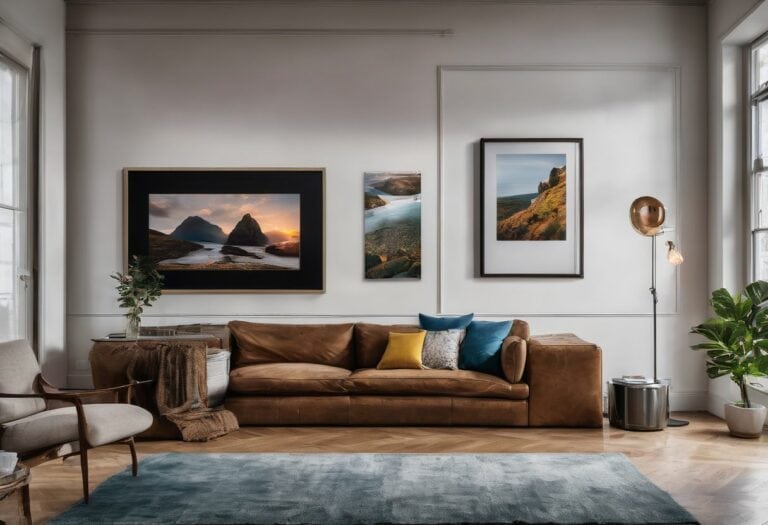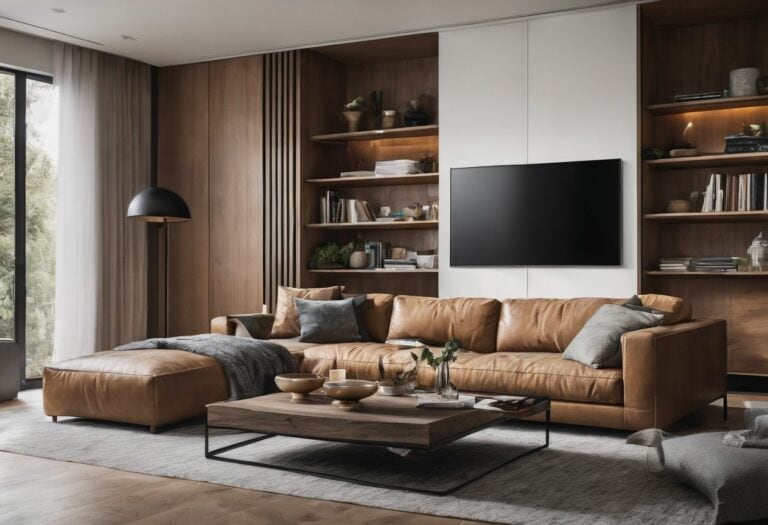What Are the Best Colors for Minimalist Houses: A Complete Guide to Choosing the Right Color Palette
Selecting the perfect color palette for your minimalist home can often feel like a quest for purity and tranquility in an overstimulated world. Homeowners are faced with countless shades and hues, each promising to bring that sleek, uncluttered look synonymous with minimalism.
However, amidst this sea of possibilities, how can you pinpoint those colors that will seamlessly weave together the ethos of ‘less is more’ within your living spaces?.
Color influences not just aesthetics but also our mood and perception of space—vital components in crafting a serene minimalist haven. Research reveals that certain colors can evoke calmness and clarity; vital attributes for any minimalist design endeavor.
Our guide illuminates the path to selecting a color scheme that fosters peace without sacrificing style.
We’ll walk you through understanding the minimalist aesthetic‘s core principles and how to balance neutrals with accent colors to create harmony and depth. With insights on lighting effects, paint finishes, texture incorporation—and even tools like house color palette generators at your disposal—you’re equipped to make confident choices in designing a refined yet cozy abode.
Ready to transform your home into a minimalist masterpiece? Let’s discover how color can simplify beauty within your walls.
The Essence of Minimalist Design and Color
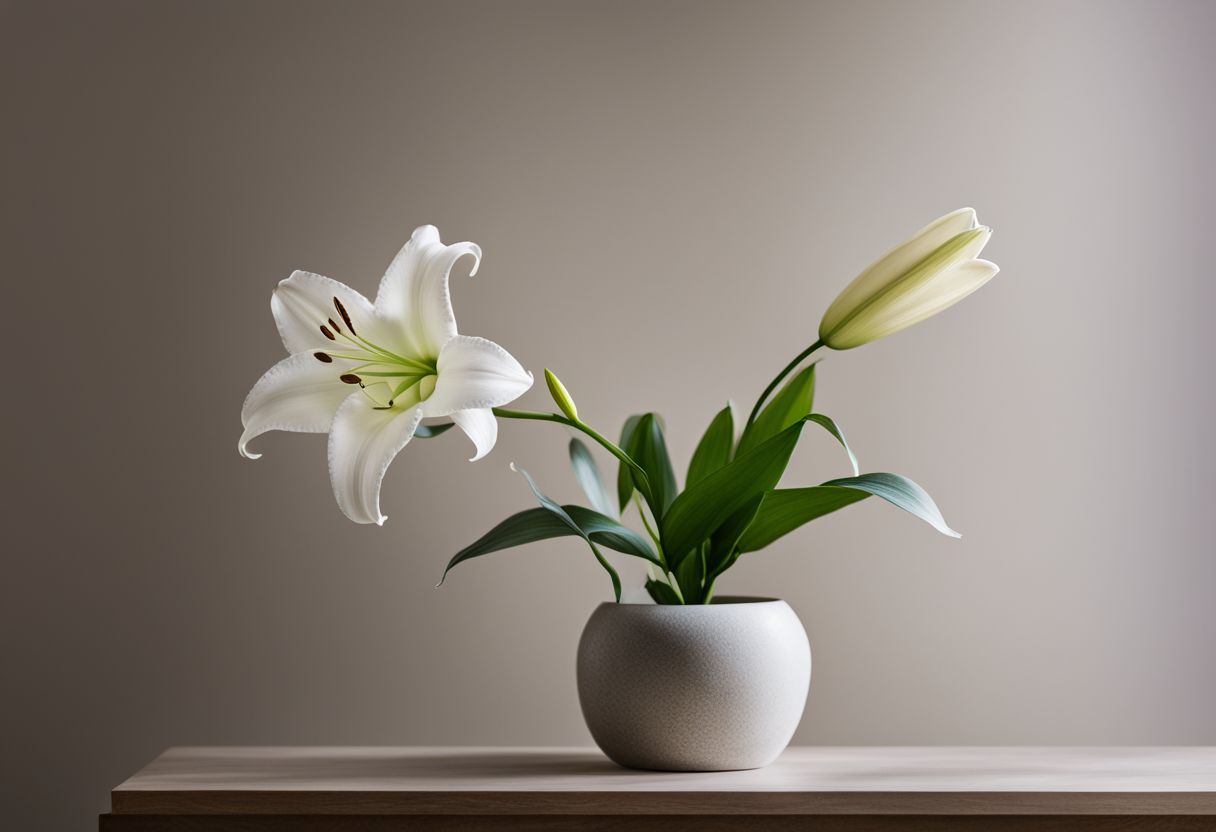
Minimalist design focuses on clean lines, simplicity, and functionality. It eliminates excess and embraces a less-is-more approach to decorating. When it comes to color, minimalist spaces prioritize neutral tones that create a sense of calm and harmony.
Understanding the minimalist aesthetic
The minimalist look is all about keeping things simple and neat. This style loves using a few colors instead of many. It’s important because the less you have, the more each thing stands out.
Imagine a room where everything has its place and there’s lots of space to breathe—you’re picturing a minimalist home! The colors are quiet, so they don’t fight for your attention.
They work together to make a calm place.
Colors in a minimalist home are like whispers—they don’t yell or clash. You’ll see lots of white, beige, and grey because these shades let other parts of the room shine. Think clean lines and no mess; that’s what makes great design here.
Every piece counts, from furniture to art on the walls.
Now that we’ve seen how less can be more with colors in minimalism, let’s explore what key hues bring this style to life in your living spaces.
The role of color in minimalist spaces
Colors in minimalist spaces are like quiet friends. They add personality without making too much noise. In a room where less is more, each color must mean something. Think of them as special guests at a party—they should get along well and not take over the conversation.
White, gray, and black set the stage in these rooms. They make walls and furniture look clean and simple. But that’s not all they do! These colors also help other things stand out—like a colorful pillow or a bright painting.
If you walked into a minimalist living room, you might see lots of white with just one red chair—that chair becomes very important because it’s different.
Nature also sneaks its way into these spaces through wood colors that make you feel calm and cozy, like being hugged by a tree without leaving your house. Imagine floors with soft brown tones; they go great with those neutrals we talked about earlier!
So remember, colors in minimalism need to play nice together but still let some pieces shine bright on their own!
What Makes Great Minimalist Design
In a minimalist space, color sets the mood without being loud. Great minimalist design starts with this idea. It uses simple colors and clean lines to make rooms feel calm and ordered.
Every piece has a job and there’s nothing extra to cause clutter or mess.
This kind of design is all about less being more. A few well-chosen items can show off your style better than lots of small things. Colors like black, white, and grays are often used because they’re classic and don’t go out of style easily.
But even with just a few colors, you can make a space that feels rich by mixing different shades and textures together.
With careful choices in color and design, you create an environment that feels both peaceful and alive at the same time – that’s what makes great minimalist interior design stand out.
Core Colors for a Minimalist Home
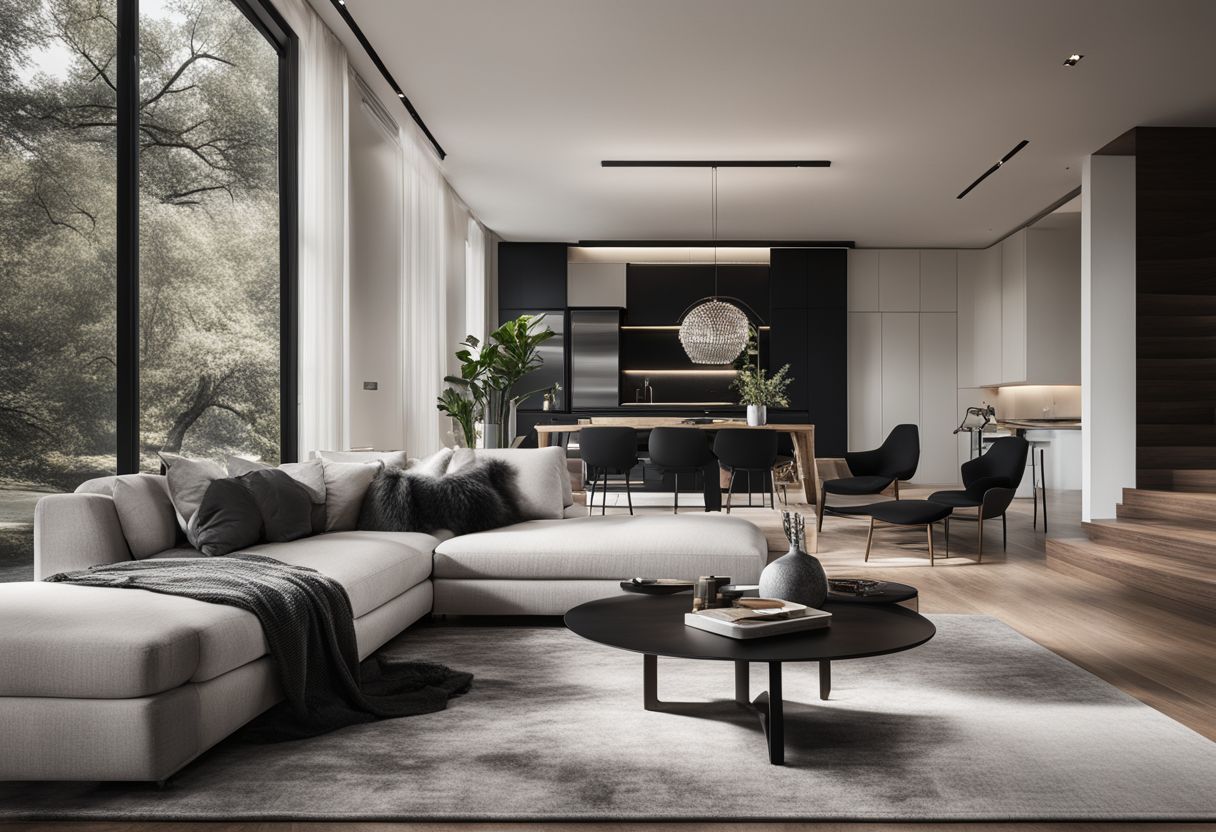
The timeless appeal of black and white, along with the serenity of grays and off-whites, form the core colors for a minimalist home. Additionally, incorporating natural wood tones can add warmth and depth to the overall color palette.
The timeless appeal of black and white
Black and white are essential colors for minimalist design. Their classic and timeless appeal makes them a popular choice for creating a clean and elegant look in your home. These colors effortlessly blend with other decor elements, providing a versatile foundation for minimalist spaces.
Incorporating black and white into your home’s color palette can create a sense of balance and simplicity, allowing other design elements to stand out.
When used together, black and white can evoke a sense of modern sophistication while also promoting visual tranquility within your living space. Black adds depth and contrast, while white brings lightness and purity to the overall aesthetic.
The combination of these two colors provides an impactful foundation that complements the minimalism ethos of simplicity and functionality in interior design.
The serenity of grays and off-whites
Grays and off-whites are the backbone of a minimalist color palette, exuding tranquility and sophistication. These neutral hues provide a clean canvas for any living space, creating a sense of openness and airiness.
Off-white shades like cream or ivory can bring warmth to a room without overpowering it, while light grays offer a modern touch that complements various design elements.
Incorporating grays and off-whites into your home’s color scheme also allows for versatility in decor choices. These colors serve as a harmonious backdrop for furniture pieces, artwork, and decorative accents.
Incorporating natural wood tones
To achieve the serene minimalist aesthetic, incorporating natural wood tones is essential. Natural wood tones bring warmth and texture to a minimalist space, complementing the neutral color scheme commonly used in minimalist designs.
By integrating natural wood tones alongside core colors, such as black and white or grays and off-whites, you can create a cohesive color palette that exudes tranquility and sophistication.
Whether it’s through wooden furniture, flooring, or decor accents, the addition of natural wood tones adds depth and character to your minimalist home while maintaining its clean and uncluttered appeal.
Incorporating natural wood tones is important for achieving the desired minimalist aesthetic due to their ability to add warmth and texture to a space while complementing the neutral color scheme commonly used in minimalist designs.
Accent Colors to Enhance Minimalist Decor
Incorporating soft pastels for a touch of warmth can add depth and visual interest to minimalist decor without overwhelming the space. To learn more about how to create a cohesive minimalist color scheme, continue reading our complete guide on choosing the right color palette for your home.
Using bold colors sparingly
Bold colors can add a pop of energy and personality to minimalist spaces when used sparingly. Red, for example, can create a striking focal point in an otherwise neutral room. Professional designers at the 2023 Real Simple Home suggest utilizing bold hues strategically to draw attention to specific elements without overwhelming the space.
Color theory provides guidance on how to incorporate bold colors effectively within a minimalist design scheme. By understanding complementary and tertiary color relationships, homeowners can confidently integrate bold accent shades like blush pink, green, or blue into their decor while maintaining a harmonious visual balance.
When applied thoughtfully, these vibrant accents can elevate the overall aesthetic of minimalist interiors without detracting from their clean and elegant appeal.
Soft pastels for a touch of warmth
When it comes to adding a touch of warmth to minimalist decor, soft pastel colors emerge as a perfect choice. These gentle hues, such as pale blue and shades of green, have the remarkable ability to create a soothing and inviting atmosphere in any space.
Soft pastels can be seamlessly incorporated as accent colors in minimalist homes, providing a sense of calm and serenity while maintaining the clean aesthetic that defines minimalism.
Their subtle yet impactful presence elevates the overall ambiance, making them an ideal addition for those looking to infuse a cozy warmth into their living spaces.
Incorporating soft pastels into minimalist decor not only introduces an element of tranquility but also complements the core neutral color palette typically associated with minimalism.
Creating a Cohesive Minimalist Color Scheme
Balancing neutrals and accents while considering the impact of texture and materials is essential for creating a cohesive minimalist color scheme that exudes harmony and simplicity.
To learn more about achieving the perfect color palette for your minimalist home, keep reading!
Balancing neutrals and accents
To create a cohesive minimalist color scheme, it’s crucial to balance neutrals and accents carefully. Neutrals like whites, grays, and blacks set the foundation for the space, while accent colors add depth and interest.
By incorporating accent colors sparingly, such as with small decor elements or furniture pieces, you can maintain the clean and uncluttered aesthetic of a minimalist design. Consider using soft pastels or bold hues to add personality without overwhelming the space.
When combining neutral colors in a color scheme, it’s essential to consider the balance between warm and cool tones. This ensures that the overall atmosphere of the space remains harmonious.
The impact of texture and materials
Texture and materials can completely transform the look and feel of a minimalist space. Smooth, glossy surfaces can create a sleek, modern aesthetic, while natural textures like wood or stone add warmth and depth to the design.
By mixing different textures such as smooth glass, soft fabrics, or rough concrete, you can add visual interest without cluttering the space.
When choosing materials for a minimalist color scheme, consider how they interact with light. Matte finishes absorb light and can make colors appear deeper and richer, while glossy finishes reflect light, making colors appear brighter.
Additionally, using materials with varying depths and sheens creates dimension within the space.
Tips for Applying Minimalist Colors in Your Home
Use natural light to your advantage by choosing colors that complement the natural lighting in your space, and selecting paint finishes that enhance the minimalist aesthetic. To learn more about creating a cohesive color scheme for your minimalist home, continue reading our complete guide!
Light and its influence on color
Light has a powerful influence on how we perceive colors in our homes. Natural light can make colors appear brighter and more vibrant, while artificial lighting can affect the warmth or coolness of a color.
Understanding how different types of light impact color can help in choosing the right minimalist color palette for your home. Rooms with little natural light can benefit from strategic paint choices, such as using lighter colors to create a sense of space or adding darker accent walls to add depth and contrast.
Additionally, considering the color temperature of lighting is crucial when selecting paint colors for minimalist interiors to ensure a cohesive and harmonious look throughout your home.
Selecting paint finishes for minimalist interiors
Light plays a crucial role in selecting paint finishes for minimalist interiors. The choice of finish can significantly impact the overall look and feel of a space. For minimalist design, matte and eggshell finishes are popular as they provide a soft, understated appearance that complements the clean lines and simplicity of minimalist decor.
These finishes also help to minimize the reflection of light, contributing to a tranquil ambiance in the room. When applying color to walls or surfaces in minimalist homes, opting for low-sheen or flat finishes is ideal; this not only adds depth to the color but also contributes to an unassuming and elegant aesthetic.
In addition, it’s important to consider using eco-friendly paint options which align with the principles of minimalism by emphasizing sustainability. Low-VOC (Volatile Organic Compounds) or VOC-free paints contribute positively to indoor air quality while maintaining the desired visual effect.
Conclusion
In conclusion, choosing the right color palette is crucial for creating a minimalist home with a clean and elegant look. The guide provides expert advice and trending color palette ideas for 2020 to help readers make informed decisions about their interior design.
By understanding the role of colors in minimalist spaces and balancing neutrals with accent shades, homeowners can create a cohesive and visually appealing environment. With careful consideration of color psychology and the impact of light, individuals can confidently apply minimalist colors to achieve professional-looking interiors for their homes.
Discover more insights on crafting the perfect minimalist space by exploring our detailed guide on what makes great minimalist design.
FAQs
1. What colors are good for a minimalist house?
For a minimalist house, simple colors like shades of blues and soft grays are good choices. They make rooms look clean and calm.
2. How do I pick the right color for my living room?
To pick the right color for your living room, look at a color wheel to find complementary colors that feel relaxing to you.
3. Can I use bright colors in a minimalist home?
Yes, you can use bright colors like primary or tertiary ones, but it’s best to use them as small accents so they don’t take over the space.
4. Why should I choose Benjamin Moore paints for my house?
People often choose Benjamin Moore paints because they offer many beautiful color options that work well with minimalist designs.
5. Is it okay to mix different shades of one color in my house?
Yes, mixing different shades of one main color is okay and can add depth while keeping your design simple and cohesive.


